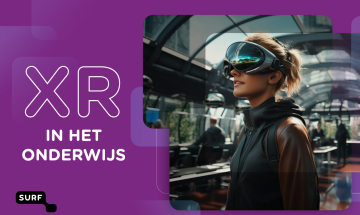XR in education
What are the possibilities, opportunities, applications, challenges and obstacles of eXtended Reality for education? Who are engaged in this? Where are we now and where are we going? Read about it in the issue XR in education.
XR's successes and challenges
The European Commission's 2023 report 'XR, Opportunities, Successes and Challenges in Health and Education' describes the state of play and assesses the strengths and weaknesses of XR use within both sectors.
98% Of the respondents believe that XR will contribute significantly to the development of their industries in the next five years. Below is a summary of the key findings.
The successes
- XR can be used to train healthcare students. By simulating emergencies and operations and providing interaction with human anatomy in 3D, students are better equipped to deal with real medical situations.
- With XR, creative opportunities in art and design are expanded. Students can create and explore clothing, architectural designs or paintings in a virtual environment.
- XR can be used to train soft skills such as communication skills, critical thinking, problem solving and teamwork.
- For students with physical disabilities or health problems, XR offers the opportunity to collaborate and participate virtually in learning processes in a safe environment. Without risks to health or the need for physical presence.
- XR can be used to make students aware of important social issues such as the environment and discrimination.
- XR can ensure a smoother and more effective learning process and provides ample opportunities for interaction, increasing student engagement and motivation.
- XR helps analyse test results and increases the accuracy of diagnoses. Diseases can be detected more easily and accurately in 3D using XR.
- Organisations can use XR cost-effectively for training. XR is currently providing safer and more effective in-service training in the fields of aviation, maritime industry, armed forces and security services.
The challenges
- Awareness and acceptance of XR remains low. Training for teachers and guidelines to integrate XR within courses can change this.
- Private investors in the EU are often reluctant to finance XR solutions. A European venture capital fund to invest in XR companies in the education sector could make investment attractive.
- XR does not always offer independent and inclusive access. Accessibility requirements and guidelines in European XR research projects are needed to change this.
- There is a lack of skilled professionals, especially designers and developers. This requires, among other things, a plan for continuing education for XR. And also for more funding for XR-related educational programmes and topics at all levels within higher education.
- There should be more projects to investigate the possible negative effects and ethical considerations related to the use of XR. The results could be used, among other things, to develop concrete recommendations for EU policy.
- More research is needed in areas including sensory augmentation and neurophysiological changes, human-avatar relationships, integration of XR with AI and data protection issues.
- Certain types of XR experiences collect and use large amounts of (personal) data, posing ethical and privacy-related risks. This requires the development of guidelines on the procedures to be followed when testing, developing, distributing and deploying solutions with new technologies.
Read the report: 'XR, Opportunities, Successes, Stories and Challenges in Health and Education'
